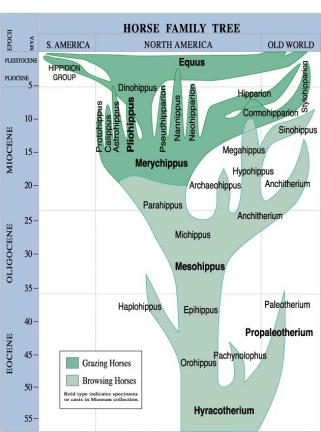Prehistoric Mammals of the Cenozoic - 65.5 Million years ago to Recent
Equids
Horses Before the Cart
Richard Paselk and Michael Lindquist
The horse family’s evolution is famous because its fossil record is unusually complete. By mapping the fossils by form and age, paleontologists have been able to create a “family tree,” to represent equid evolution.
This is a very simplified tree. Each name represents a group of related species. Notice how evolution does not follow a straight line, but branches in many directions. Ironically,the evolution of the horse takes place almost exclusively in North America, but then goes extinct. All modern North American horses are descended from Old World horse brought to America by people.
In the table below and the display at the Museum each Epoch is represented by fossils of a single genus. Equids in the Museum's collection are shown in bold on the diagram.
Pleistocene epoch/Recent
1.81-0 million years ago
Equus is the genus of all modern equids, including horses, zebras, and asses. We can see how radically the horse family has changed over time when comparing Equus with Hyracotherium, at the bottom of the page, a cat-sized ancestor of the Eocene. Equus have one-toed long legs, the skull has no facial fossae, and straight high-crowned grazing teeth. Our Pleistocene tooth shows the typical folded enamel crests lined with cement. Equus evolved in North America, diversifying into a variety of species during the Pliocene. Some Equus species migrated to to the Old World during the first Pliocene glaciations, then diversified into the various species we see today - zebra in Africa, onager and asses in the deserts of the Mideast and North Africa, and the true horse from Asia to Europe. Horses went extinct in North America during the Pleistocene, but were reintroduced to the continent in 1519 by the Spanish conquistadors.
Compare:
- Skull fossils and drawings
- Equid sizes (after Lull, 1913)
Pliocene epoch
5.33-1.81 million years ago
Pliohippus appears during the mid Miocene as a three-toed horse. The side toes are gradually lost during the early Pliocene. Though not considered a direct ancestor, it was very close to modern horses. Pliohippus differs from Equus in two significant ways. First, a Pliohippus tooth is strongly curved while an Equus tooth is straight. Second, Pliohippus has deep facial fossae, while Equus has no facial fossae.
Miocene epoch
23.0-5.33 million years ago
Merychippus was well adapted for running on hard ground, standing tip-toed supported by springy ligaments. It still had three toes, but the central toe grew in size and developed a large convex hoof. The high-crowned grazing teeth with their thick layer of cement can be seen in the jaw fragment (front and top views)
Oligocene epoch
33.9-23.0 million years ago
The end of the Eocene in North America saw a drying of climate, reduction of forest and the arrival of grasses. Mesohippus appears suddenly in the late Eocene, surviving into the middle Oligocene It responded to these changes in a variety of ways. It was a bit larger (24" at the shoulder) and leggier than Hyracotherium, which would have made it a faster animal on the more open plains. Mesohippus was still pad-footed, but had only three toes on both its hind and front feet, as seen in our foot specimen. It had adapted more of its teeth for grinding, as needed with a grass diet, as seen in our jaw fragment (side and top views). Mesohippus skull shows an elongated face and snout, as well as a facial fossa (depression), a feature which will become complex in some future horses.
Compare:
Eocene epoch
55.8-33.9 million years ago
Hyracotherium (once known as Eohippus = dawn horse) was the earliest known equid. It was a small, cat-size, mammal, 10-20" at the shoulder. Hyracotherium and its decedents survived the entire Eocene with little fundamental change - they remained small with the same body-form, had padded feet (like a dog) instead of hooves with three toes in the back and four in the front, and had small brains. The major change was in tooth structure (see jaw fragment) and number. Essentially a change in diet from fruit and soft foliage to tougher plant material required more grinding surfaces, resulting in a transition from three molars and two premolars on each side of each jaw to five "molars."
The horse family tree was digitally redrawn by Holly Harvey from Bruce J. MacFadden, Fossil Horses. Cambridge University Press, Cambridge (1992)
Artist's interpretations of landscapes with equids ("Restored from a skeleton in the American Museum") and equid skull drawings are from William R. Scott, A History Land Mammals in the Northern Hemisphere. Macmillan, New York (1913). Equid outline drawings are from Lull (1913), and the foot and tooth sets are after O. C. Marsh, Am. Jour. Sci. xvii, pp 499-505 (1879).
References: There is a vast literature on the evolution of horses. A good recent book is: Bruce J. MacFadden, Fossil Horses. Cambridge University Press, Cambridge (1992). Two good web sites are: Horse Evolution by Kathleen Hunt (lots of references etc.) and the Fossil Horse Cybermuseum hosted by the Florida Museum of Natural History
Last modified 9 May 2005 | ©1998, Cal Poly Humboldt NHM















